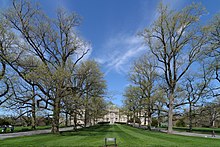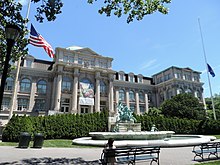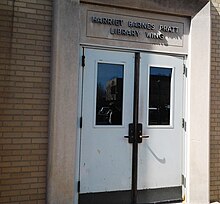
The Solomon R. Guggenheim Museum, often referred to as The Guggenheim, is an art museum at 1071 Fifth Avenue between 88th and 89th Streets on the Upper East Side of Manhattan in New York City. It hosts a permanent collection of Impressionist, Post-Impressionist, early Modern, and contemporary art and also features special exhibitions throughout the year. It was established by the Solomon R. Guggenheim Foundation in 1939 as the Museum of Non-Objective Painting, under the guidance of its first director, Hilla von Rebay. The museum adopted its current name in 1952, three years after the death of its founder Solomon R. Guggenheim. It continues to be operated and owned by the Solomon R. Guggenheim Foundation.

Brooklyn Botanic Garden (BBG) is a botanical garden in the borough of Brooklyn in New York City. The botanical garden occupies 52 acres (21 ha) in central Brooklyn, close to Mount Prospect Park, Prospect Park, and the Brooklyn Museum. Designed by the Olmsted Brothers, BBG holds over 14,000 taxa of plants and has over 800,000 visitors each year. It includes a number of specialty gardens, plant collections, and structures. BBG hosts numerous educational programs, plant-science and conservation, and community horticulture initiatives, in addition to a herbarium collection.

The New York Botanical Garden (NYBG) is a botanical garden at Bronx Park in the Bronx, New York City. Established in 1891, it is located on a 250-acre (100 ha) site that contains a landscape with over one million living plants; the Enid A. Haupt Conservatory, a greenhouse containing several habitats; and the LuEsther T. Mertz Library, which contains one of the world's largest collections of botany-related texts. As of 2016, over a million people visit the New York Botanical Garden annually.

The Bartow–Pell Mansion is a historic house museum at 895 Shore Road in the northern section of Pelham Bay Park, within the New York City borough of the Bronx. The two-story building, designed in the mid-19th century by an unknown architect, has a Greek Revival facade and federal interiors and is the last surviving manor house in the Pelham Bay Park area. The grounds surrounding the mansion take up 9 acres (3.6 ha) and include a three-story carriage house; terraced gardens overlooking Long Island Sound to the east; and a small burial plot for the Pell family, which once occupied the land.

George Valentine Nash was an American botanist. He was the Head Gardener and Curator of the Plantations at the New York Botanical Garden, for whom he did field work in the Bahamas, South Florida and Haiti.

The Morgan Library & Museum is a museum and research library at 225 Madison Avenue in the Murray Hill neighborhood of Manhattan in New York City, U.S. Completed in 1906 as the private library of the banker J. P. Morgan, the institution has more than 350,000 objects. As of 2024, the museum is directed by Colin B. Bailey and governed by a board of trustees.
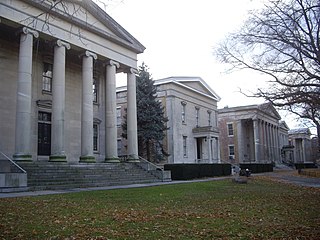
Sailors' Snug Harbor, also known as Sailors Snug Harbor and informally as Snug Harbor, is a collection of architecturally significant 19th-century buildings on Staten Island, New York City. The buildings are set in an 83-acre (34 ha) park along the Kill Van Kull in New Brighton, on the North Shore of Staten Island. Some of the buildings and the grounds are used by arts organizations under the umbrella of the Snug Harbor Cultural Center and Botanical Garden.

Bronx Park is a public park along the Bronx River, in the Bronx, New York City. The park is bounded by Southern Boulevard to the southwest, Webster Avenue to the northwest, Gun Hill Road to the north, Bronx Park East to the east, and East 180th Street to the south. With an area of 718 acres (2.91 km2), Bronx Park is the eighth-largest park in New York City.

The Queensland Herbarium is situated at the Brisbane Botanic Gardens, Mount Coot-tha, in Brisbane, Queensland, Australia. It is part of Queensland's Department of Environment and Science. It is responsible for discovering, describing, monitoring, modelling, surveying, naming and classifying Queensland's plants, and is the focus for information and research on the state's flora, fauna and plant communities.
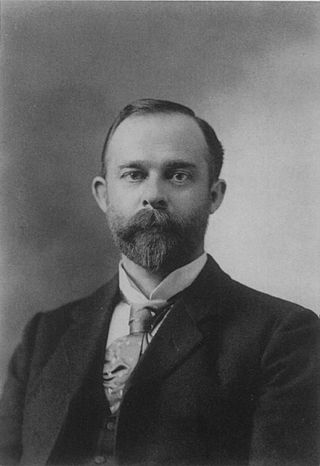
Lucien Marcus Underwood was an American botanist and mycologist of the 19th and early 20th centuries.

The Enid A. Haupt Conservatory is a greenhouse at the New York Botanical Garden (NYBG) in the Bronx, New York, United States. The conservatory was designed by Lord & Burnham Co. in the Italian Renaissance style. Its major design features are inspired by the Palm House at the Royal Botanic Gardens at Kew, and Joseph Paxton's Crystal Palace.
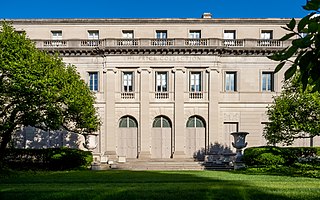
The Henry Clay Frick House is a mansion and museum building on Fifth Avenue, between 70th and 71st streets, on the Upper East Side of Manhattan in New York City. Designed by Thomas Hastings as the residence of the industrialist Henry Clay Frick, the house contains the Frick Collection museum and the Frick Art Reference Library. The house and library building are designated as a New York City landmark and National Historic Landmark.

The W New York Union Square is a 270-room, 21-story boutique hotel operated by W Hotels at the northeast corner of Park Avenue South and 17th Street, across from Union Square in Manhattan, New York. Originally known as the Germania Life Insurance Company Building, it was designed by Albert D'Oench and Joseph W. Yost and built in 1911 in the Beaux-Arts style.
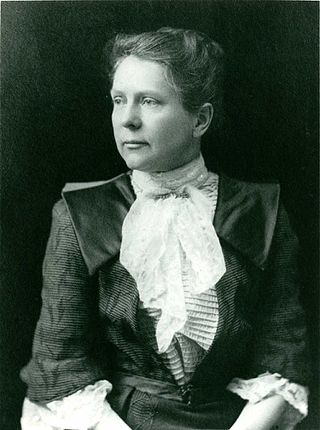
Elizabeth Gertrude Britton was an American botanist, bryologist, and educator. She and her husband, Nathaniel Lord Britton, played a significant role in the fundraising and creation of the New York Botanical Garden. She was a co-founder of the precursor body to the American Bryological and Lichenological Society. She was an activist for the protection of wildflowers, inspiring local chapter activities and the passage of legislation. Elizabeth Britton made major contributions to the literature of mosses, publishing 170 papers in that field.
Henry Hurd Rusby (1855–1940) was an American botanist, pharmacist and explorer. He discovered several new species of plants and played a significant role in founding the New York Botanical Garden and developing research and exploration programs at the institution. He helped to establish the field of economic botany, and left a collection of research and published works in botany and pharmacology.

The National Herbarium of New South Wales was established in 1853. The Herbarium has a collection of more than 1.4 million plant specimens, making it the second largest collection of pressed, dried plant specimens in Australia, including scientific and historically significant collections and samples of Australian flora gathered by Joseph Banks and Daniel Solander during the voyage of HMS Endeavour in 1770.
Inez Maria Haring was an American botanist and plant collector, best known for her work in bryology as the Assistant Honorary Curator of Mosses at the New York Botanical Garden beginning in 1945.

Howard Samuel Irwin Jr. was an American botanist and taxonomist who specialized in the genus Cassia and worked as an administrator at the New York Botanical Garden, Long Island University, and the Brooklyn Botanic Garden.

Patricia May Holmgren is an American botanist. Holmgren's main botanical interests are the flora of the U.S. intermountain west and the genera Tiarella and Thlaspi. Holmgren was the director of the herbarium at the New York Botanical Garden from 1981–2000, and editor of Index Herbariorum from 1974–2008.
John James Pipoly III is an American botanist and plant collector. He is a leading expert on the systematics and taxonomy of the genus Ardisia within the Myrsinoideae, as well as the family Clusiaceae.


